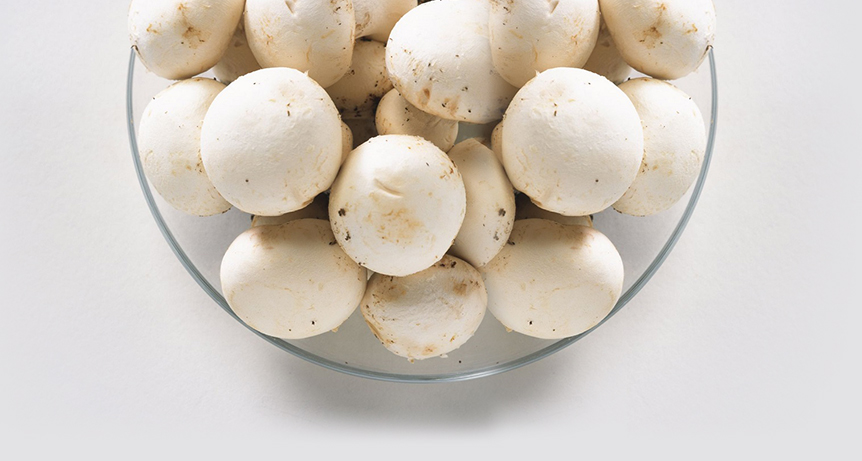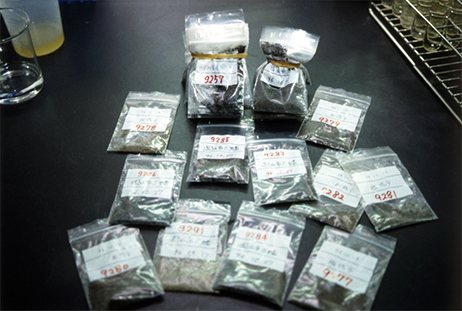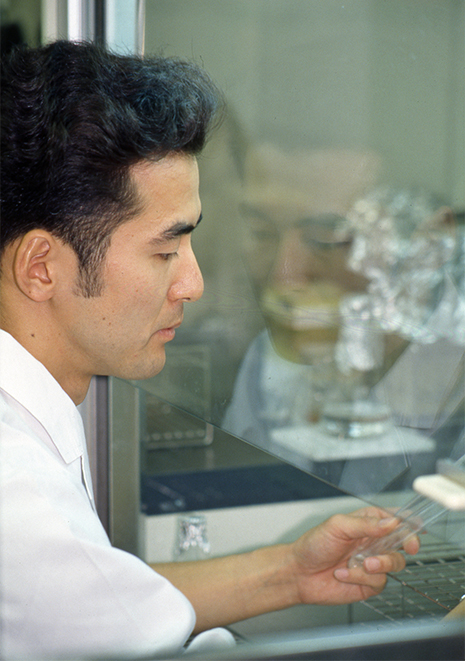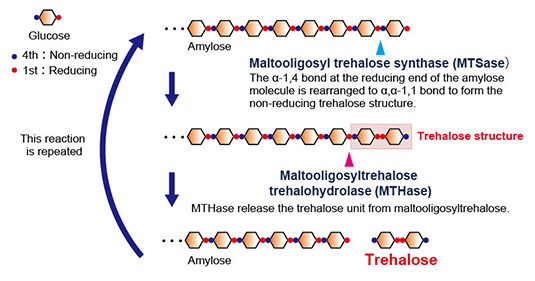
- Trehalose is a food ingredient that can be used in a variety of food applications that include ready to eat foods and baked goods such as bread and cakes for maintaining fresh flavors and textures.
Trehalose is heat and acid stable. It also inhibits starch retrogradation and protein denaturation and retains moisture. These benefits are well received in the food industry and its applications are expanding to meat products and fresh produce.
This story is about the history of Hayashibara Co., Ltd. (Nagase Viita at present) with Trehalose, which started years ago from the development of commercial production method to the present.
 Also called mushroom sugar
Also called mushroom sugar
Trehalose – unique, low-yeild carbohydrate
Trehalose is a naturally occurring carbohydrate that can be produced by a number of microscopic animals and plants. It is particularly abundant in mushrooms, therefore, it has historically be called mushroom sugar.
Trehlaose is usually produced by these animals and plants in higher concentrations in response to environmental stress conditions such as dehydration or freezing. As drying or freeing occurs water is drawn away from important biologic structures in the cells. If this happens to a high degree it can be fatal to the cells and ultimately to the organism. The trehalose can replace the water during these times and spare the organism from irreversible damage.
Owing to its intriguing characteristics, trehalose was expected to have numerous uses, however, its production because it was manufactured by extraction from yeast, which results in relatively low yields. Other methods of production, such as a fermentative using microorganisms, and genetic modification of plants by inserting enzyme genes were developed, but none of them resulted in commercially viable production yields.
As a result, trehalose was sold at a price around 30,000 to 50,000 yen/kg. This cost could be justified in some pharmaceuticals or cosmetics, but could only rarely be used for processing food. Creating a manufacturing process that would lower the price of trehalose was a highly sought technology.
Trehlaose is usually produced by these animals and plants in higher concentrations in response to environmental stress conditions such as dehydration or freezing. As drying or freeing occurs water is drawn away from important biologic structures in the cells. If this happens to a high degree it can be fatal to the cells and ultimately to the organism. The trehalose can replace the water during these times and spare the organism from irreversible damage.
Owing to its intriguing characteristics, trehalose was expected to have numerous uses, however, its production because it was manufactured by extraction from yeast, which results in relatively low yields. Other methods of production, such as a fermentative using microorganisms, and genetic modification of plants by inserting enzyme genes were developed, but none of them resulted in commercially viable production yields.
As a result, trehalose was sold at a price around 30,000 to 50,000 yen/kg. This cost could be justified in some pharmaceuticals or cosmetics, but could only rarely be used for processing food. Creating a manufacturing process that would lower the price of trehalose was a highly sought technology.
Quest for
economical mass production
The turning point occurred in the early 1990s. Although Nagase Viita’s expertise had been in the enzymatically production of sweeteners from starch, the company had not been successful in developing a unique products for a few years. There was an urgent need to develop innovative products that would underlie the company’s revenue for the future.
Because of this situation, the company organized a special project to specifically "find novel carbohydrates." While a lot of ideas were submitted during a brainstorming session, the comment, "How about carbohydrate that is similar to sugar but not sugar?" inspired the project group. Together with marketing ideas and suggestions from the sales team, the goal was clarified. This was the beginning of the development of the "carbohydrate that is similar to sugar but not sugar”.
To create a novel carbohydrate, the company employed a method to interact starch with enzymes naturally made by microorganisms that are present in the soil.
Because of this situation, the company organized a special project to specifically "find novel carbohydrates." While a lot of ideas were submitted during a brainstorming session, the comment, "How about carbohydrate that is similar to sugar but not sugar?" inspired the project group. Together with marketing ideas and suggestions from the sales team, the goal was clarified. This was the beginning of the development of the "carbohydrate that is similar to sugar but not sugar”.
To create a novel carbohydrate, the company employed a method to interact starch with enzymes naturally made by microorganisms that are present in the soil.
 Part of the soil samples collected
Part of the soil samples collected
Soil samples were collected at diverse locations throughout Japan. Suspensions from soil samples were applied to a culture plate and kept at various temperatures (27-37°C) for 1 or 2 days. Colonies developed on the plate were separated and pure cultures were proliferated in a fluid culture. The microorganisms were observed for by-products from their interaction with starch. In the event of any novel enzymatic activities, thin-layer chromatography was used to separate the individual substances in the mixtures, and the undefined spots underwent further investigation.
Discovery which brought
new ideas to academic societies
Researchers spent their days analyzing more than 2,000 soil samples. One day, a researcher happened to find a microorganism that generated a trehalose-producing enzyme in a soil sample collected from Okayama City. The microorganism belongs to the genus Arthrobacter.
Mr. Maruta, the researcher still remembers the moment when he was observing the substances produced from the enzymatic reaction, "Glucose was detected at the top of the thin-layer chromatography plate. A maltose-like substance was also detected in the second position, which contained two glucose molecules. However, its color tone was different from that of maltose and its position on the plate was slightly different from that of maltose. The substance did not react to silver nitrate, which reacts only with reducing sugars. This meant it was not a reducing sugar like maltose. This could be trehalose!”
Mr. Maruta enjoyed science since early childhood, and appeared to be a natural born researcher. He was assigned to the Amase Institute not long after joining the company was on course to find the identity or the mystery substance on the thin-layer chromatography plate.
The identification process of “the maltose-like substance” continued using a series of sophisticated analytical methods including gas chromatography, high-performance liquid chromatography, mass spectrometry, and nuclear magnetic resonance (NMR) spectroscopy. Finally, after months of painstaking work “the maltose-like substance” was revealed to be trehalose. The final critical test was the discovery that the substance could be enzymatically cleaved into two glucose molecules by an enzyme, “trehalase” that is found in the digestive system of many animals and is highly specific for trehalose.
The trehalase reactions related to trehalose production from starch were discovered to be intramolecular rearrangement and hydrolysis by two enzymes. Starch (amylose) consists of chains of glucose units primarily arranged in a line and attached by α-1,4 bonds. The first enzymatic reaction takes the glucose molecule at the end of the starch molecule (reducing end) and flips the molecule around, attaching the terminal glucose in an α,α-1,1 bond. Therefore the two end glucose molecules now formed a trehalose molecule, which is still attached to the starch molecule.This intramolecular rearrangement process was not known before this discovery. The second enzyme identifies the trehalose molecule and then breaks the bond between the second and third glucose in the starch chain, releasing the terminal trehalose molecule. These reactions are repeated to produce more trehalose.
Mr. Maruta, the researcher still remembers the moment when he was observing the substances produced from the enzymatic reaction, "Glucose was detected at the top of the thin-layer chromatography plate. A maltose-like substance was also detected in the second position, which contained two glucose molecules. However, its color tone was different from that of maltose and its position on the plate was slightly different from that of maltose. The substance did not react to silver nitrate, which reacts only with reducing sugars. This meant it was not a reducing sugar like maltose. This could be trehalose!”
Mr. Maruta enjoyed science since early childhood, and appeared to be a natural born researcher. He was assigned to the Amase Institute not long after joining the company was on course to find the identity or the mystery substance on the thin-layer chromatography plate.
The identification process of “the maltose-like substance” continued using a series of sophisticated analytical methods including gas chromatography, high-performance liquid chromatography, mass spectrometry, and nuclear magnetic resonance (NMR) spectroscopy. Finally, after months of painstaking work “the maltose-like substance” was revealed to be trehalose. The final critical test was the discovery that the substance could be enzymatically cleaved into two glucose molecules by an enzyme, “trehalase” that is found in the digestive system of many animals and is highly specific for trehalose.
The trehalase reactions related to trehalose production from starch were discovered to be intramolecular rearrangement and hydrolysis by two enzymes. Starch (amylose) consists of chains of glucose units primarily arranged in a line and attached by α-1,4 bonds. The first enzymatic reaction takes the glucose molecule at the end of the starch molecule (reducing end) and flips the molecule around, attaching the terminal glucose in an α,α-1,1 bond. Therefore the two end glucose molecules now formed a trehalose molecule, which is still attached to the starch molecule.This intramolecular rearrangement process was not known before this discovery. The second enzyme identifies the trehalose molecule and then breaks the bond between the second and third glucose in the starch chain, releasing the terminal trehalose molecule. These reactions are repeated to produce more trehalose.
 Kazuhiko Maruta discovered a microorganism, which generates a trehalose-producing enzymes.
Kazuhiko Maruta discovered a microorganism, which generates a trehalose-producing enzymes.

It was found that this method converts starch to trehalose at an efficiency of 80% or more. This was a major discovery that a microorganism could produce trehalose from starch at such a high yield. While many other researchers were investigating the production of trehalose by other methods it was commonly thought that the production of trehalose directly from starch was unachievable. This innovation by Nagase Viita not only surprised the carbohydrate industry, but also resulted in the birth of a leading novel product that would significantly impact the future of the company.
The entire research center, including Mr. Maruta, was in a jubilant mood. While many other international companies were searching for an economical process to produce trehalose, it was Nagase Viita that opened the door to the world's first mass production of trehalose.
The entire research center, including Mr. Maruta, was in a jubilant mood. While many other international companies were searching for an economical process to produce trehalose, it was Nagase Viita that opened the door to the world's first mass production of trehalose.
Future opportunities and perspectives
 Trehalose Symposium
Trehalose Symposium
In order to accommodate the year-by-year increase in production volume, the manufacturing plant was extended in 2016, and a system for enhanced production was also established.
In addition, since 1997 Nagase Viita has been hosting an annual event called the "Trehalose Symposium". The symposium provides opportunities for internal and external researchers to present various research results on basic properties of trehalose, its applications for foods, cosmetics, medical care, and agricultural/livestock products.
Nagase Viita will continue to pursue the possibilities of trehalose, an inspiring ingredient to enhance taste, health, and beauty.



